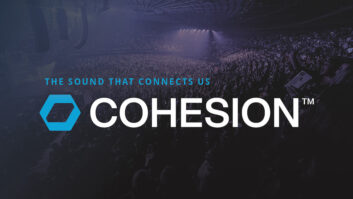
The Waco Brothers began as one of Jon Langford’s side projects, the cowpunk alter-ego of British punk band The Mekons. But more than 30 years after The Mekons formed, the Wacos’ raw, explosive sound is every bit as vital as the group that made Langford a force in alternative music.
The Wacos recorded and mixed their latest album, Going Down in History, for Bloodshot Records in Chicago, the label and city that Langford has called home for 20-plus years. Bloodshot has been an excellent fit for Langford and his various bands (Pine Valley Cosmonauts and Skull Orchard, as well as The Mekons), with its self-proclaimed support of “insurgent country” music. Also a great fit for Langford’s projects: engineer Mike Hagler and his Kingsize Sound Labs studio.
“The first time I worked with Jon Langford was on Retreat from Memphis [1994], a Mekons record,” Hagler says. “My business partner at the time, David Trumfio, introduced me to Jon.”
Trumfio eventually moved to Los Angeles and opened a sister studio, Kingsize Sound Labs L.A., while Hagler now shares Kingsize Chicago with engineer/bassist John Abbey. “When I first saw this space, it was a former woodshop—a big empty room filled with sawdust, leaky ceilings and a busted water pipe,” Hagler recalls. “But it was perfect for me because I knew the rent would be affordable. This is the fifth studio I’ve built, and it’s the biggest.”
The 2,500-square-foot Chicago facility includes a large tracking space with 20-foot ceilings, three iso rooms and two control rooms—Abbey’s on the main floor, and Hagler’s in a loft space. Hagler’s room has less headroom than Abbey’s, but Hagler has fine-tuned it over time to where he’s totally comfortable and happy with the sound.

Kingsize Sound Labs studio
“Downstairs we have a 1980s Neve 66—a converted broadcast console from WGN Studios,” Hagler says. “So if somebody I’m working with wants to mix on a Neve and get that sound, we have that, whereas in my room I have a lot of outboard preamps. I’m more modular. I have a lot of 500 Series and rackmount stuff. Most of the time John [Abbey] likes working downstairs and I’m in my room.”
Hagler frequently refers to himself as “impatient.” He likes to record live bands quickly and hear results just as fast. This also fits well with Langford’s MO—The Wacos are well-loved as a live, loud band.
“Jon [Langford] has a very punk-rock aesthetic,” Hagler explains. “Everybody’s in the same room, and sometimes even the vocals are live with the band, to an SM7. This record was tracked in two live six-hour-long sessions.”
Hagler offers analog recording as well as digital at Kingsize; this time out he captured the sessions in Pro Tools. “I have the Burl Mothership, and those converters are really nice-sounding,” he says. He also has a carefully curated mic collection. Whereas the Shure SM7’s good rejection worked well for live keeper vocals, Hagler also made use of a 1930s RCA 44 BX and sometimes one of his Pearlman mics (TM1 or TM47) for vocal overdubs.
“Jon and Dean [Schlabowske] share most of the lead vocals and the songwriting,” Hagler says. “But everybody sings—the others all sing backup.”
Vocal mics usually went to an Avedis MA5 or BAE 1073 preamp. “I also have the AwTAC Awesome preamp,” Hagler says. “They’re really high-end and they have an EQ section; I used that on some stuff, too.
“I do things in the studio at a very gut level,” he continues. “That’s part of my not being very patient. I have a large palette to work with, so if I’m getting a little frustrated with something, or the vocalist is sounding a little rough or a little dark that day, I might quickly switch to a brighter preamp. If there’s too much attack, I might try something slower.
“As far as compression, I have Distressors and Tube-Techs, and the Pendulum DS8 tube compressor, but I’ve noticed over the years that when I’m using digital, I use less and less compression because I like to have more control on the mix side.”

Kingsize Sound Labs control room
Hagler situated Tracy Dear and his mandolin in an iso booth with sight lines to the main studio, miked up with a Coles 4038 and a Pearlman mic for his vocals; but the remaining four musicians were in the studio together, with a little baffling around Joe Camarillo’s drums, and between guitarists Langford and Schlabowske.
The engineer captured Alan Doughty’s bass with a combination of a Neumann U 47 FET and a DI, and the guitar amps—mainly the studio’s vintage Ampeg, Fender, and Vox amps—were miked up with a Royer 121 and a classic ribbon each.
“The guitar amps were probably four feet apart, with Royers on the speakers and RCA 74s—the smaller version of the 44—perpendicular to the amps, about three feet away, so the side is facing it,” Hagler says. “That way you get kind of a figure-eight. I can also use the ribbon as kind of a room mic, and I might pepper that with another close mic—a 57 along with the Royer—for a little brighter sound.”

Engineer Mike Hagler
Overall, the Wacos’ record is all fans will hope and expect—loud and fast with plenty of edge and twang, and lyrics that are somehow enthusiastic and cynical at once. For example, the album leads with Schlabowske singing “DIYBYOB,” which you might guess is a tongue-in-cheek send-up of the music industry: “This is the first track from the last album/No one knows which way this ship will head/Sailors take warning/Red eyes in the morning/You can’t kill us, we’re already dead.”







